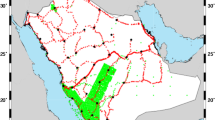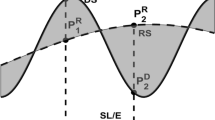Abstract
This paper provides numerical examples for the prediction of height anomalies by the solution of Molodensky's boundary value problem. Computations are done within two areas in the Canadian Rockies. The data used are on a grid with various grid spacings from 100 m to 5 arc-minutes. Numerical results indicate that the Bouguer or the topographicisostatic gravity anomalies should be used in gravity interpolation. It is feasible to predict height anomalies in mountainous areas with an accuracy of 10 cm (1σ) if sufficiently dense data grids are used. After removing the systematic bias, the differences between the geoid undulations converted from height anomalies and those derived from GPS/levelling on 50 benchmarks is 12 cm (1σ) when the grid spacing is 1km, and 50 cm (1σ) when the grid spacing is 5′. It is not necessary, in most cases, to require a grid spacing finer than 1 km, because the height anomaly changes only by 3 cm (1σ) when the grid spacing is increased from 100 m to 1000 m. Numerical results also indicate that, only the first two terms of the Molodensky series have to be evaluated in all but the extreme cases, since the contributions of the higher order terms are negligible compared to the objective accuracy.
Similar content being viewed by others
References
Armold, K., 1960, Numerische Beispiele zur strengen Theorie der Figur der Erde. Veröff, Geod. Inst. Potsdam, No. 16.
Bracewell, R.N., 1986, The Fourier transform and its applications. Second edition, McGraw-Hill, New-York.
Brigham, E.O., 1988, The fast Fourier transform and its application. Prentice Hall.
Brovar, V.V., 1964, On the solution of Molodensky's boundary value problem. Bulletin Geodesique, No.72, pp. 167–173.
Haagmans, R., E. de Min and M. van Gelderen, 1993, Fast evaluation of convolution integrals on the sphere using 1D FFT, and a comparison with existing methods for Stokes integral. Manuscripta Geodaetica, Vol. 18, pp. 227–241.
Heiskanen, W.A. and H. Moritz, 1967, Physical Geodesy. W.H. Freeman and Company.
Li, Y.C., 1993, Optimized spectral geoid determination. USGE Report 20050, Department of Geomatics Engineering, The University of Calgary, Calgary, Alberta, Canada.
Klose, U and K.H. Ilk, 1993, A solution to the singularity problem occurring in the terrain correction formula. Manuscripta Geodaetica, Vol. 18, pp. 263–279.
Molodensky, M.S., V.F. Eremeev and M.I. Yurkina, 1962, Methods for study of the external gravitational field and figure of the Earth. Israel Prog. Sci. translations, Jerusalem.
Mainville, A., R. Forsberg and M.G. Sideris, 1992, Global positioning system testing of geoids computed from geopotential models and local gravity data: a case study. J. Geophys. Res. 97 (B7), pp. 11,137–11,147.
Moritz, H., 1968, Linear solutions of the geodetic boundary-value problem. Publ. Deut. Geod. Komm., A.58.
Moritz, H., 1969, Nonlinear solution of the geodetic boundary-value problem. OSU Rept. No. 126, Department of Geodetic Science and Surveying, The Ohio State University, Ohio, USA.
Moritz, H., 1980, Advanced physical geodesy. Herbert Wichmann Verlag, Karlsruhe, Abacus Press, Tunbridge Wells Kent.
Noë, H., 1980, Numerical investigation on the problem of Molodensky. Mitteilungen, der geodätischen Inctitute der Technicshen Universität Graz, Folge 36.
Pellinen, L.P., 1972, On the identity of various solutions of Molodensky's problem with the help of a small parameter. Int. Symp. on Earth gravity Models and related Problems, Saint Louis, Missouri, August (also Geod. Aerofotosyemka, 65–71, 1974).
Rapp, R.H., Y.M. Wang and N.K. Pavis, 1991, The Ohio State 1991 geopotential and sea surface topography harmonic coefficient models. OSU Rept. No. 410, Department of Geodetic Science and Surveying, The Ohio State University, Ohio, USA.
Schwarz, K.P., 1983, ed., Techniques to predict gravity anomalies and deflections of the vertical in mountainous areas. Division of Surveying Engineering Technique Report, No. 30004, The University of Calgary.
Schwarz, K.P., M.G. Sideris and R. Forsberg, 1990, The use of FFT techniques in physical geodesy. Geophys. J. Int. 100, pp. 485–514.
Sideris, M.G., 1994, Regional geoid determination. In Geoid and Its Geophysical Interpretations, pp. 77–94, edited by P. Vanicek and N.T. Christou, CRC Press Inc.
Sideris, M.G., 1984, Computation of gravimetric terrain corrections using fast Fourier transform techniques. UCSE Rep. #20007, Division of Surveying Engineering, the University of Calgary.
Sideris, M.G. and R. Forsberg, 1990, Review of geoid prediction methods in mountainous regions. IAG Symposia No. 106: Determination of the Geoid, pp. 51–62.
Sideris, M.G. and Y.C. Li, 1992, Improved geoid determination for levelling by GPS. Proceedings of the Sixth Int. Geodetic Symposium on Satellite Positioning, Columbus, OH, March 17–20, pp. 873–883.
Sideris, M.G. and Y.C. Li, 1993, Gravity field convolutions without windowing and edge effects. Bulletin Geodesique, Vol. 67, pp. 107–118.
Sideris, M.G. and K.P. Schwarz, 1986, Solving Molodensky's series by fast Fourier transform techniques. Bulletin Geodesique, Vol. 60, pp. 51–63.
Stokes, G.G., 1949, On the variation of gravity on the surface of the earth. Trans. Cambridge Phil. Soc., V. 8, pp. 672–695.
Strang van Hees, G., 1990, Stokes' formula using fast Fourier techniques. Manuscripta Geodaetica, Vol. 15, pp. 235–239.
Tscherning, C.C. and R. Forsberg, 1992, Harmonic continuation and gridding effects on geoid height prediction. Bulletin Geodesique, Vol. 66, pp. 41–53.
Wang, Y.M., 1993, Comments on proper use of the terrain correction for the computation of height anomalies. Manuscripta Geodaetica, Vol. 18, pp.53–57.
Wichiencharoen, C., 1982, The indirect effects on the computation of geoid undulations. OSU Rept. 336, Department of Geodetic Science and Surveying, The Ohio State University, Ohio, USA.
Author information
Authors and Affiliations
Rights and permissions
About this article
Cite this article
Li, Y.C., Sideris, M.G. & Schwarz, KP. A numerical investigation on height anomaly prediction in mountainous areas. Bulletin Géodésique 69, 143–156 (1995). https://doi.org/10.1007/BF00815483
Received:
Accepted:
Issue Date:
DOI: https://doi.org/10.1007/BF00815483




